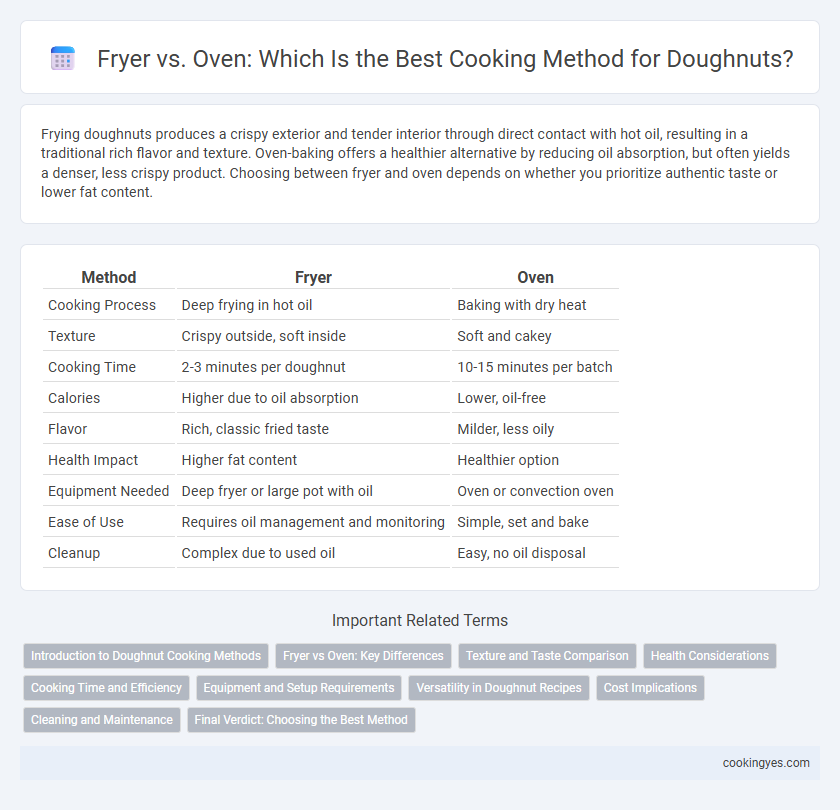Frying doughnuts produces a crispy exterior and tender interior through direct contact with hot oil, resulting in a traditional rich flavor and texture. Oven-baking offers a healthier alternative by reducing oil absorption, but often yields a denser, less crispy product. Choosing between fryer and oven depends on whether you prioritize authentic taste or lower fat content.
Table of Comparison
| Method | Fryer | Oven |
|---|---|---|
| Cooking Process | Deep frying in hot oil | Baking with dry heat |
| Texture | Crispy outside, soft inside | Soft and cakey |
| Cooking Time | 2-3 minutes per doughnut | 10-15 minutes per batch |
| Calories | Higher due to oil absorption | Lower, oil-free |
| Flavor | Rich, classic fried taste | Milder, less oily |
| Health Impact | Higher fat content | Healthier option |
| Equipment Needed | Deep fryer or large pot with oil | Oven or convection oven |
| Ease of Use | Requires oil management and monitoring | Simple, set and bake |
| Cleanup | Complex due to used oil | Easy, no oil disposal |
Introduction to Doughnut Cooking Methods
Doughnut cooking methods primarily include frying and baking, each impacting texture and flavor distinctly. Frying immerses doughnuts in hot oil, producing a crispy exterior and airy interior, while baking uses dry heat to yield a lighter, less greasy result. Choosing between a fryer and oven depends on desired crispiness, fat content, and cooking efficiency.
Fryer vs Oven: Key Differences
Fryer cooking method for doughnuts offers rapid, even heat distribution resulting in a crispy exterior and soft interior, whereas oven baking provides a healthier alternative with less oil absorption but a denser texture. Frying achieves higher temperatures around 350degF to 375degF, creating the characteristic golden-brown crust, while oven baking typically uses lower temperatures between 325degF and 350degF. The fryer method also retains traditional doughnut flavor and moisture better compared to the drier outcome from ovens, making it the preferred choice for classic doughnut recipes.
Texture and Taste Comparison
Frying doughnuts results in a crispy exterior and a light, airy interior due to the rapid cooking at high oil temperatures, enhancing traditional flavor profiles with a slightly caramelized crust. Oven-baked doughnuts produce a softer, cake-like texture with less oil absorption, offering a milder taste and reduced greasiness but lacking the crunch and richness characteristic of fried versions. Choosing the frying method intensifies flavor and texture contrasts, while baking provides a healthier, less oily alternative with a more uniform crumb.
Health Considerations
Frying doughnuts typically involves submerging them in hot oil, which increases calorie content and saturated fat intake, potentially raising health risks like heart disease. Oven baking doughnuts significantly reduces oil absorption, resulting in lower fat and calorie content while preserving flavor and texture. Choosing an oven over a fryer promotes a healthier option by minimizing unhealthy fats and supports a balanced diet without sacrificing taste.
Cooking Time and Efficiency
Fryer cooking method for doughnuts typically requires 2 to 3 minutes per batch, ensuring a crispy exterior and soft interior through rapid oil heat transfer. Oven baking, in contrast, demands 10 to 15 minutes, resulting in a drier texture but reduced oil absorption and cleaner operation. Fryers offer higher efficiency in achieving traditional doughnut quality quickly, while ovens provide a healthier alternative with longer cooking times and less energy consumption for small batches.
Equipment and Setup Requirements
Frying doughnuts requires specialized equipment such as deep fryers capable of maintaining consistent oil temperatures around 350degF, ensuring even cooking and achieving the classic crispy exterior. Oven baking demands standard baking ovens with precise temperature control, typically set between 350degF and 375degF, along with well-prepped baking trays or pans to prevent sticking. Fryers involve more complex setup for oil filtration and ventilation systems, whereas ovens require straightforward setups with minimal safety concerns related to hot oil management.
Versatility in Doughnut Recipes
Frying doughnuts yields a classic crispy exterior and tender interior favored in traditional recipes, while oven baking offers a healthier alternative with less oil absorption and easier handling of diverse flavors and toppings. Fryers excel in producing a consistent golden crust, ideal for yeast and cake doughnuts requiring deep frying, whereas ovens accommodate creative variations like filled or layered doughnuts with customizable finishes. Choosing between fryer and oven depends on recipe complexity and desired texture, impacting versatility in doughnut preparation and presentation.
Cost Implications
Frying doughnuts requires considerable oil consumption and frequent oil changes, increasing operational costs compared to baking. Oven baking reduces oil expenses and lowers energy usage over time, making it a more cost-efficient method for large batches. However, initial oven investment may be higher, but long-term savings in oil and maintenance often offset this expense.
Cleaning and Maintenance
Deep-frying doughnuts requires regular cleaning of the fryer to prevent oil buildup and residue, which can affect taste and safety, making maintenance more labor-intensive compared to oven baking. Ovens offer easier cleaning with fewer greasy residues, as they use dry heat and often come with self-cleaning features or non-stick surfaces that reduce time spent on upkeep. Choosing an oven for doughnut cooking minimizes ongoing maintenance costs and effort while maintaining consistent cooking conditions.
Final Verdict: Choosing the Best Method
Fryer-cooked doughnuts deliver a classic crispy exterior and tender interior due to rapid oil heat transfer, preserving authentic texture and flavor. Oven-baked doughnuts offer a healthier alternative with reduced fat content but often sacrifice the traditional richness and delicate crust. Selecting the best method hinges on desired taste profile and nutritional preferences, with frying favored for traditional authenticity and baking suited for a lighter option.
Fryer vs Oven for doughnut cooking method Infographic

 cookingyes.com
cookingyes.com